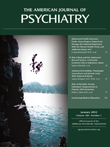In This Issue
Clinical Guidance: Comparative Risk of Mortality Among Psychotropic Medications in Dementia
Haloperidol had 1.5 times the risk of mortality of other psychotropics in patients with dementia studied in an outpatient VA setting by Kales et al. (p. Original article: 71). Risperidone, valproic acid and derivatives, and olanzapine had intermediate risk, and quetiapine had the lowest risk (figure). Haloperidol was more frequently prescribed by nonpsychiatrists and more often in older, medically ill African Americans. Quetiapine was prescribed in lower doses, often for less ill patients, but was associated with increased parkinsonian symptoms. The increased risk of haloperidol was primarily in the first 30 days. Corbett and Ballard point out in their editorial (p. Original article: 7) that the efficacy of quetiapine in the behavioral disturbances associated with dementia is questionable, whereas risperidone and olanza-pine have significant beneficial effects and therefore would be preferred for treatment.

Valproate for dementia patients has a mortality risk similar to that for risperidone or olanzapine (Kales et al., p. 71)
Does Religion Protect Against Depression in Offspring of Depressed Patients?
A depressive episode in the grown children of depressed parents was only one-tenth as likely among those who reported that religion or spirituality was highly important to them as among those who rated it less highly. On the other hand, Miller et al. (CME, p. Original article: 89) found that church attendance and religious denomination over the 10-year period were not related to depression outcome in this high-risk group. In an editorial, Blazer (p. Original article: 10) notes that the average age of the offspring in this study was 29 and that young adults' spirituality is less traditional than their parents' beliefs.
Clinical Guidance: Association of Irritability, Impulsive Hurtfulness, and Risk Taking With Future Depression, Delinquency, and Substance Abuse in Adolescents
Irritability predicted depression, whereas impulsive and hurtful behaviors were more strongly related to delinquency, over the course of adolescence in a twin study by Stringaris et al. (p. Original article: 47). These traits were also linked to their outcomes by common genetic diathesis. In a study by Schneider et al. (p. Original article: 39), increased risk-taking behavior in an experimental setting predicted later substance abuse in adolescents. In an editorial, Wamboldt (p. Original article: 4) points out that early identification of these traits should guide early treatment interventions.
Mental Health Insurance Parity in Oregon
Expenses for mental illness and substance abuse treatment increased only slightly after implementation of Oregon's law requiring parity between insurance coverage for these disorders and coverage for other conditions. The changes in the four commercial plans examined by McConnell et al. (p. Original article: 31) were similar to those in self-insurance plans exempt from parity. The periods compared were the 2 years before and 2 years after the law took effect in 2007. Management of behavioral health benefits through nonquantitative treatment limitations, such as documentation of medical necessity, prior authorization, and utilization review, was allowed but had to conform with restrictions on medical-surgical coverage. This similarity to the federal parity law implemented in 2009 suggests to editorialist Susan Busch (p. Original article: 1) that the new federal requirement of insurance parity will not “break the bank.”
Clinical Guidance: Effects of Paroxetine Treatment During PTSD Exposure Therapy
Patients with posttraumatic stress disorder (PTSD) from experiences during the World Trade Center attack responded better to paroxetine, up to 50 mg/day, than placebo over 10 weeks of exposure therapy that included weekly 90-minute guided imagery sessions and cognitive-behavioral exercises. Schneier et al. (p. Original article: 80) report that by week 10, 42% of patients in the paroxetine group remitted, compared to 17% in the placebo group. The differences did not persist for patients who continued therapies beyond 10 weeks; by week 22, the remission rate was 45% for both treatments among those remaining in the study.



